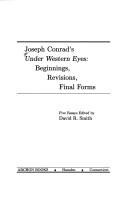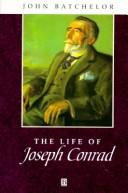| Listing 1 - 10 of 69 | << page >> |
Sort by
|
Book
ISBN: 9782851971784 2851971786 Year: 2014 Volume: 109 Publisher: Paris: L'Herne,
Abstract | Keywords | Export | Availability | Bookmark
 Loading...
Loading...Choose an application
- Reference Manager
- EndNote
- RefWorks (Direct export to RefWorks)
Ce Cahier dédié à Joseph Conrad se compose de textes d’origines et de longueur très diverses. Le Cahier inclut dix-neuf textes de Conrad, qui pour certains ont été traduits pour la première fois. Figurent également une dizaine de textes traduits de l’anglais (Chinua Achebe, John Berger, John Cowper Powys, Bob Dylan, Malcolm Lowry, Robert Penn Warren, J.L. Borgès, Virginia Woolf ) ainsi qu’un impressionnant florilège d’extraits. À ceci s’ajoute une importante moisson de contributions de spécialistes universitaires, de lecteurs, et d’écrivains francophones (une cinquantaine), qui témoignent de la présence vivante de Conrad dans la culture contemporaine. Le volume évoque d’abord les années de formation qui vont de l’enfance polonaise à l’émergence de l’homme de lettres anglais. Déjà se profilent la difficulté du choix de vivre de sa plume, et un rapport complexe à l’argent : l’écrivain, naturalisé anglais en 1884, avait tendance à vivre largement au-dessus de ses moyens et souffrait d’endettement chronique. Le succès commercial n’arriva qu’avec Fortune (1913). Dans un deuxième temps, l’ouvrage explore l’oeuvre en devenir. Le volume fait apparaître l’importance primordiale de la langue et de la culture françaises qui constituent tout l’arrière plan permettant de saisir les formes si multiples de l’univers conradien. Cet enracinement francophone apparaît autant dans la vie vécue de l’écrivain, que dans les influences (Flaubert, Maupassant, Loti, Anatole France, Rimbaud) et amitiés littéraires (André Gide, Saint John Perse, Valéry Larbaud). Enfin, nous avons pris à la lettre Marguerite Duras qui souhaitait que la présence de Conrad reste vivante dans les écritures de notre temps, et nous avons suivi sa trace littéraire jusqu’à nos jours, en recueillant des contributions d’auteurs contemporains, parmi lesquels Philippe Roth, Salman Rushdie, David Lodge, Joyce Carol Oates pour la langue anglaise, et Christian Bobin, Patrick Deville, Marie Darrieussecq, Michel Déon, Jacques Rancière pour la France. Nous avons accordé une place importante au cinéma qui s’est intéressé à Conrad pratiquement dès la parution de ses oeuvres jusqu’à nos jours (Julien Duvivier, Alfred Hitchcock, Francis Ford Coppola, Andrzej Wajda, Patrice Chéreau, Chantal Akerman) sans parler des innombrables adaptations pour les télévisions de tous les pays. La plasticité de son oeuvre se prête merveilleusement à ce nouvel art qu’est la bande dessinée, à la création musicale et chorégraphique (Bob Dylan, Philip Glass, Tarik O’Regan, Angelin Preljocaj).
Book
ISBN: 9789042033238 Year: 2011 Volume: 5 Publisher: Amsterdam [etc.] Rodopi
Abstract | Keywords | Export | Availability | Bookmark
 Loading...
Loading...Choose an application
- Reference Manager
- EndNote
- RefWorks (Direct export to RefWorks)
Book
ISBN: 9789045003931 Year: 2008 Publisher: Amsterdam Antwerpen Atlas
Abstract | Keywords | Export | Availability | Bookmark
 Loading...
Loading...Choose an application
- Reference Manager
- EndNote
- RefWorks (Direct export to RefWorks)
Book
ISBN: 9789004292420 9004292438 9789004292437 900429242X 1336207515 Year: 2015 Publisher: Boston, Massachusetts : Brill | Rodopi,
Abstract | Keywords | Export | Availability | Bookmark
 Loading...
Loading...Choose an application
- Reference Manager
- EndNote
- RefWorks (Direct export to RefWorks)
Since the publication of Joseph Conrad’s “Author’s Note” (1920) to A Set of Six (1908), readers have been aware that the plot for the Napolonic tale “The Duel” derived from an existing account. What has been unknown till now is the large number of venues in which that account variously appeared. This volume traces the tale’s fascinating genealogy and the immediate contemporary source that inspired Conrad’s 1907 story. A transcription of the story’s typescript-manuscript sheds light on the story’s development. Conrad’s “The Duel”: Sources/Text will interest several readerships. Scholars engaged in historical and textual research can explore how Conrad drew upon, reworked, and transformed the story’s sources. The relationships between the tale’s initial draft and final form will interest scholars of genetic questions, and teachers of short fiction and of creative writing will find this an invaluable volume for exploring how source materials alter during the creative process.
Book
ISBN: 9004308997 9789004308992 9789004308978 9004308970 Year: 2016 Publisher: Leiden, Netherlands ; Boston, [Massachusetts] : Brill Rodopi,
Abstract | Keywords | Export | Availability | Bookmark
 Loading...
Loading...Choose an application
- Reference Manager
- EndNote
- RefWorks (Direct export to RefWorks)
When Joseph Conrad’s novel Chance appeared in serial form in the New York Herald in 1912 and in book form in 1914 it established the author’s financial security for the first time. Following years of struggle to reach a wide audience for his fiction, Conrad benefitted from the American marketing of this novel for the women readers of romance. Aggressive advertising promoted the writer’s new focus on a female protagonist and Conrad’s division of the story’s location between land and sea. The novel proved popular and lucrative. Yet in spite of its economic success, Chance remains one of Conrad’s less well-known narratives. This fresh new collection of essays from both young and established scholars opens up a lively critical debate taking Chance beyond the status of best-selling romance. In a striking re-evaluation of the novel these writers examine Chance ’s innovative narrative strategies, its up-to-the-minute commentary on female politics, contemporary ethics, as well as its antecedents in classical debate and the significance of Conrad’s last use of his seaman narrator Marlow.

ISBN: 020802302X Year: 1991 Publisher: Hamden Archon Book
Abstract | Keywords | Export | Availability | Bookmark
 Loading...
Loading...Choose an application
- Reference Manager
- EndNote
- RefWorks (Direct export to RefWorks)

ISBN: 0631199128 Year: 1996 Publisher: Oxford UK Cambridge, Mass.USA Blackwell
Abstract | Keywords | Export | Availability | Bookmark
 Loading...
Loading...Choose an application
- Reference Manager
- EndNote
- RefWorks (Direct export to RefWorks)
Book
Year: 1950 Publisher: London Longmans, Green & Co for the British Council and the National Book League
Abstract | Keywords | Export | Availability | Bookmark
 Loading...
Loading...Choose an application
- Reference Manager
- EndNote
- RefWorks (Direct export to RefWorks)
Conrad, Joseph, 1857-1924 -- Criticism and interpretation
Multi
ISBN: 9789004694972 9789004691971 Year: 2024 Publisher: Leiden ;Boston Brill
Abstract | Keywords | Export | Availability | Bookmark
 Loading...
Loading...Choose an application
- Reference Manager
- EndNote
- RefWorks (Direct export to RefWorks)
Book
ISBN: 9781410399243 Year: 2022 Publisher: Farmington Hills Gale
Abstract | Keywords | Export | Availability | Bookmark
 Loading...
Loading...Choose an application
- Reference Manager
- EndNote
- RefWorks (Direct export to RefWorks)
Uniquely among Conrad biographies, Joseph Conrad provides an expansive tour of its subject by drawing together a wealth of written and visual resources never before juxtaposed in a single volume. Profiting from the distinctive format of documentary volumes in the Dictionary of Literary Biography series, this book coordinates such materials as hundreds of letters between Conrad and others, excerpts from his fiction and autobiographical writing, nearly a hundred contemporary reviews, and assessments by his publishers and many friends and visitors. Furthermore, 150 images-portraits, landscapes, annotated maps, key documents, and more-lavishly illustrate the people and places that Conrad knew, in addition to how his works were advertised and appeared in magazine and book forms. Throughout this carefully curated book, Mark D. Larabee's amply detailed chapter introductions, image captions, and headnotes foreground the cultural and historical contexts within which Conrad wrote, while explaining the significance of those materials in the larger story that the volume unfolds. This rich and thoughtfully organized array places Conrad's personal and public writing in direct conversation with the wider world, clearly showing readers how the complex interplay of Conrad's childhood, literary influences and reading, voyages, aesthetic goals, and marketplace demands combined to create his literary life and enduring artistic works. Rounding out the volume are a detailed chronology, a complete list of Conrad's publications, and an extensive guide to further readings and resources. This original and stimulating treatment of Conrad presents an author whose portrayals of person and nation, culture, gender, and race resonate ever more importantly today.
| Listing 1 - 10 of 69 | << page >> |
Sort by
|

 Search
Search Feedback
Feedback About UniCat
About UniCat  Help
Help News
News